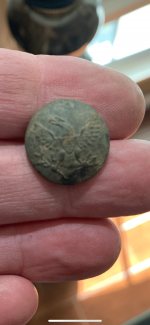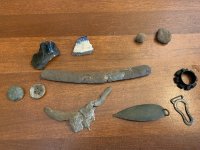Florida Finder
Bronze Member

 My better half let me go detecting at on of my fort sites this morning as long as I mowed the grass when I got back. I’ve learned to keep those promises over the years. My best find was this 1830s 1 piece artillery coat button. Also found a shot and in shot ball, a broken lead bar and a parasol piece. Also found an old fishing lure, a garter piece and a few shards. My question is we’re parasols around during the 1830s or were they later? Thanks for looking!
My better half let me go detecting at on of my fort sites this morning as long as I mowed the grass when I got back. I’ve learned to keep those promises over the years. My best find was this 1830s 1 piece artillery coat button. Also found a shot and in shot ball, a broken lead bar and a parasol piece. Also found an old fishing lure, a garter piece and a few shards. My question is we’re parasols around during the 1830s or were they later? Thanks for looking!Amazon Forum Fav 👍
Upvote
15




